It’s possible that I shall make an ass of myself. But in that case one can always get out of it with a little dialectic. I have, of course, so worded my proposition as to be right either way (K.Marx, Letter to F.Engels on the Indian Mutiny)
Wednesday, August 24, 2022
Kenyans sue UK government for colonial land theft
A group in the tea-growing Kericho region is seeking redress from Britain. The land taken from them is now owned by multinational corporations.

Multinational corporations continue to make massive profits from
tea plantations on stolen land
A group of Kenyans has filed a suit against the British government at the European Court of Human Rights (ECHR). They are seeking an investigation and eventual compensation for land stolen under colonial rule.
The ECHR is not a European Union body, and the UK is party to it.
"The UK government has ducked and dived, and sadly avoided every possible avenue of redress. We have no choice but to proceed to court for our clients so that history can be righted," said lawyer Joel Kimutai Bosek, who is representing the group in Kenya's western Kericho region.
UN: Kenyans' human rights were violated
Much of the land taken in Kericho is now home to tea plantations that make foreign corporations millions every year, as Kenya is the world's leading black tea exporter by volume.
"Today, some of the world's most prosperous tea companies, like Unilever, Williamson Tea, Finlay's and Lipton, occupy and farm these lands and continue to use them to generate considerable profits," the plaintiffs said in a statement.
The United Nations has said more than half a million Kenyans from the Kericho area suffered gross violations of human rights, including unlawful killings and displacement, during British colonial rule, which ended in 1963.
Many continue to suffer economic consequences from the theft of their land, the United Nations has also said.
The British government has rarely apologized or offered redress for crimes committed by its colonial forces. However, in 2013, it agreed on a multimillion dollar compensation settlement for Kenyans tortured by British soldiers during an uprising that occured shortly before the end of colonial rule.
UK officials have yet to comment on the lawsuit.
es/rt (AFP, Reuters)
Sudan: After Darfur visit, ICC prosecutor urges UN to seek justice
The International Criminal Court's chief prosecutor, Karim Khan, gave the first ever Security Council briefing from within a country where the court is pursuing justice. Darfur is a region of western Sudan.

UN says 300,000 were killed in the Sudanese government's scorched-earth campaign against the people of Darfur
The chief prosecutor of the International Criminal Court has urged the UN Security Council to do more to deliver justice for the people of Darfur in a landmark address on Tuesday.
The UN says that 300,000 people were killed and two and a half million fled their homes during the ethnic conflict that began in 2003. Former Sudanese President Omar al-Bashir will be tried for genocide after he backed mostly-Arab militias with a scorched earth policy against Darfur's ethnic minority.
The ICC's Karim Khan recently visited the region in person and met with internally displaced people. He said the people of Darfur "are tired of promises."
"The simple truth is that the nightmare for thousands of Darfuris has not ended,'' he said in a virtual briefing from the Sudanese capital, Khartoum.

Karim Khan recently visited Darfur himself
"And that nightmare of their experiences in large part continues because meaningful justice and accountability has not been felt in the manner that is required, or in my respectful view was anticipated by the council in 2005."
He called for the Security Council to hold a session on Sudan, adding that if members heard directly from those still living in Darfur's internally-displaced people camps, it would "reawaken our commitment to humanity."
Setbacks with the new government
Khan's Tuesday briefing was the first time an ICC prosecutor addressed the Security Council while in a country where the court is pursing justice.
Al-Bashir, who was Sudan's president at the time of the Darfur conflict, has remained in prison after he was overthrown in 2019 by military leaders who eventually ushered in civilian elections.
However, another military coup last October has been "a backwards step from the strong period of cooperation" in recent years, Khan said in a report circulated to the Security Council.
"The insecurity that persists following the events of October 25, 2021, also continues to cause disruption to investigative activity," the report added.
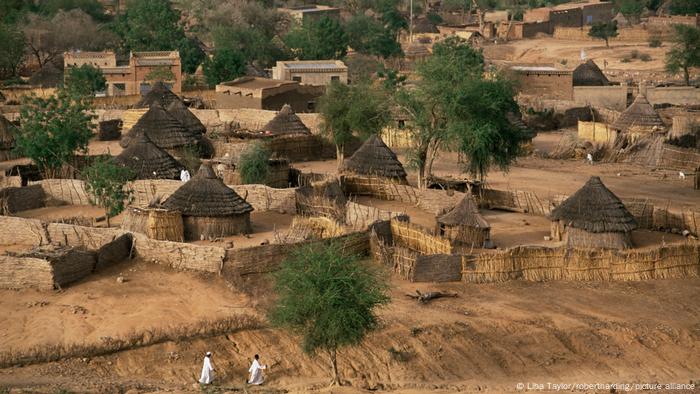
Members of Sudan's former government under Omar al-Bashir will be tried for crimes against humanity in Darfur
First trial underway
The first ICC trial to do with the atrocities in Darfur kicked off in April in The Hague. The defendant was Ali Muhammad Ali Abd-Al-Rahman, also known as Ali Kushayb, who was a leader in the Arab Janjaweed militia. He pleaded innocent to all 31 charges of war crimes.
Meanwhile, al-Bashir faces charges of genocide and crimes against humanity from his time as president.
Two of his top officials at the time, former interior minister Abdel-Rahim Muhammad Hussein and former security chief Ahmed Haroun, have also been accused of war crimes and crimes against humanity by the ICC.
All three remain in custody in Khartoum.
zc/jsi (AP, AFP)
Ethiopia: Tigray rebels accuse government forces of new, large offensive
Rebels in Tigray said the government in Addis Ababa has launched a "large-scale offensive." The claims could not be independently verified as the Tigray region is under a communications blackout.
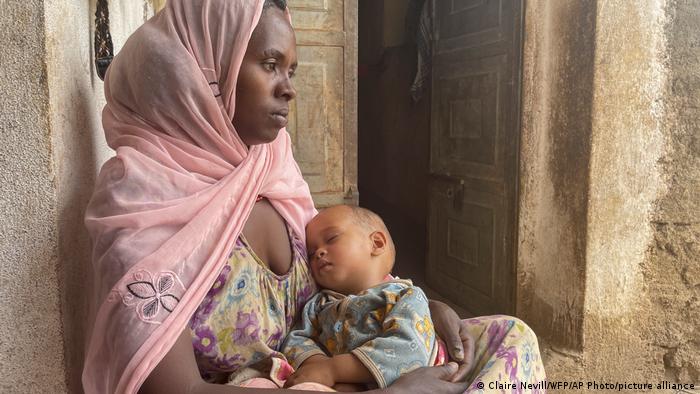
The war between Ethiopian government forces and Tigrayan rebels pushed parts of Tigray towards famine conditions
Rebels in the Tigray region of Ethiopia accused the central government in Addis Ababa and militias aligned with them of launching what it termed a "large-scale offensive" Wednesday.
The government in Addis Ababa did not immediately respond to the claims by the Tigray People's Liberation Front (TPLF). It was not possible to independently verify the claims made by the TPLF due to the information blackout in that part of the country.
The "large-scale offensive" would put an end to a months-old cease-fire that had held a fragile peace in the country.
What is known about the 'large-scale offensive'?
Getachew Reda, a TPLF spokesman, told the AFP news agency, "They launched the offensive early this morning around 5:00 a.m. local time (0200 GMT). We are defending our positions."
On Twitter, Reda said the "large-scale offensive" had been launched "against our positions in the southern front," and accused Ethiopia's army, special forces and Amharic militias from the neighboring region of being responsible for the incursion.
Residents and Reda said the fighting broke out near the town of Kobo.
A farmer in the region told Reuters news agency, "I am hearing sound of heavy weapons starting from this morning."
Tigrai Television, a state-run regional station, reported, "Ethiopian forces along with Amhara special forces and Amhara militias started a large-scale attack around 5:00 a.m."
What does this mean for the conflict between Ethiopia and the TPLF?
The claim of a fresh offensive comes five months after the TPLF and the Ethiopian government reached a truce after more than a year of a brutal war that began in November 2020.
The Ethiopian National Defense Force had accused the TPLF on Tuesday of trying to "defame" the army with claims that Ethiopian government forces were moving against their positions or using heavy weapons to shell them.
In recent weeks, Prime Minister Abiy Ahmed and the TPLF have traded barbs while simultaneously raising the prospects for peace talks to bring the war to an end. The two sides are unable to come to an agreement on who should lead the negotiations.
The TPLF is also demanding the restoration of basic services to the region's 6 million people prior to the start of any peace talks. Tigray has been without communications or banking services and imports of fuel are restricted which limits the amount of aid that can be brought into the region.
The war was responsible for displacing millions, creating famine conditions in parts of Tigray and the deaths of thousands of civilians.
ar/sms (AFP, Reuters)
As many as 40 million children are "one disease" from catastrophe as the Horn of Africa and Sahel experience the worst drought in four decades, according to UNICEF.
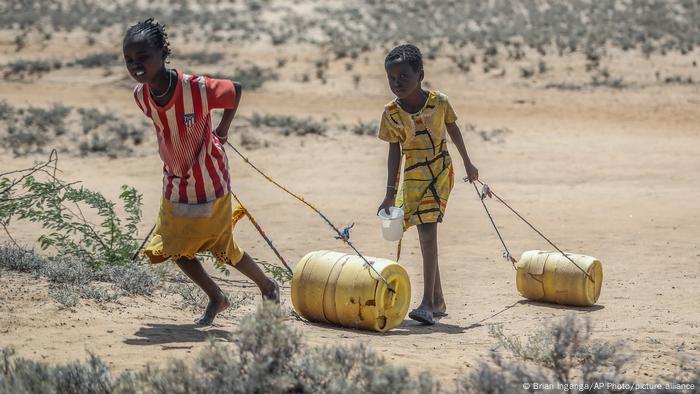
UNICEF said that drought and conflict were driving up water insecurity leading to high levels of water vulnerability
The United Nations International Children's Emergency Fund (UNICEF) has warned that children in the Horn of Africa and Sahel regions "could die in devastating numbers unless urgent support is provided."
That's as the number of drought-stricken people in Ethiopia, Kenya and Somalia — without access to adequate supplies of water — rose from 9.5 million to 16.2 million in the space of just five months, according to the relief agency.
"When water either isn't available or is unsafe, the risks to children multiply exponentially," UNICEF Executive Director Catherine Russell said. "Across the Horn of Africa and the Sahel, millions of children are just one disease away from catastrophe," she added.
Twin threat of drought and conflict
UNICEF said drought and conflict in Burkina Faso, Chad, Mali, Niger and Nigeria were driving up water insecurity, resulting in 40 million children facing high to extremely high levels of water vulnerability.
According to UNICEF's figures, 2.8 million children in the Horn of Africa and Sahel regions are already suffering from severe acute malnutrition, meaning that they are at risk of dying from waterborne diseases at a rate 11 times higher than well-nourished children.
Nearly two-thirds of children affected are under the age of 5. The organization said that as natural water sources dried up, the knock-on effect was significant increases in the price of water. In parts of Kenya prices had risen by as much as 400% while in parts of Somalia increases of up to 85% were reported.
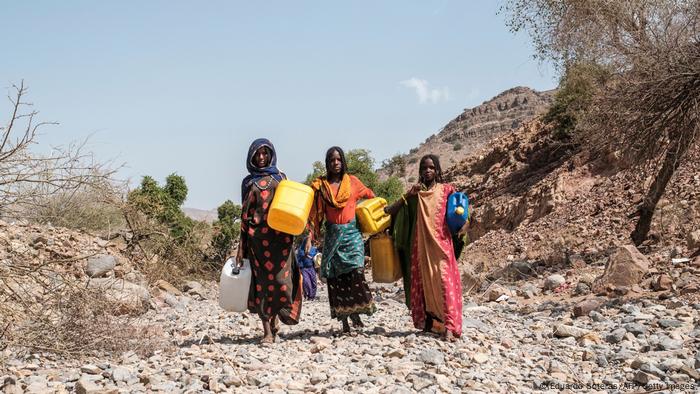
CLIMATE CRISIS: A WORLD LACKING WATER
Famine risk on the Horn of Africa
Ethiopia, Kenya and Somalia are currently experiencing their worst drought in over 40 years after successive failed rainy seasons. The dry conditions have led to a severe food security issue in the region, with 22 million people at risk of starvation. More than 1 million people have been forced to leave their homes during the drought, which is expected to continue for months.
123456789
The worst drought in decades
Climate change and extreme weather events have increased natural disasters over the past 50 years, according to the World Meteorological Organization and the UN Office for Disaster Risk Reduction.
The rainy season for much of sub-Saharan Africa is April through June. Not enough rain fell during that period.
This year would be the third consecutive year where the East African and Horn of Africa regions have not received enough rain.
Although droughts are common in this region, they have become more severe. There is growing scientific evidence that climate change has exacerbated the effects of droughts.
DPA contributed to this report
Edited by: Rob Turner
China warns of 'severe' threat to harvest from worst heatwave on record
Jing Xuan TENG
Tue, August 23, 2022

China's autumn harvest is under "severe threat" from high temperatures and drought, authorities have warned, urging action to protect crops in the face of the country's hottest summer on record.
The world's second-largest economy has been hit by record temperatures, flash floods and droughts this summer -- phenomena that scientists have warned are becoming more frequent and intense due to climate change.
Southern China has recorded its longest sustained period of high temperatures and sparse rain since records began more than 60 years ago, the agriculture ministry said.
Four government departments issued a notice on Tuesday urging the conservation of "every unit of water" to protect crops.

"The rapid development of drought superimposed with high temperatures and heat damage has caused a severe threat to autumn crop production," the statement said.
China produces more than 95 percent of the rice, wheat and maize it consumes, but a reduced harvest could mean increased demand for imports in the world's most populous nation -- putting further pressure on global supply already strained by the conflict in Ukraine.
Temperatures as high as 45 degrees Celsius (113 degrees Fahrenheit) have led multiple Chinese provinces to impose power cuts, as cities struggle to cope with a surge in demand for electricity that is partly driven by people cranking up the air conditioning to cope with the heat.
The megacities of Shanghai and Chongqing have cut outdoor decorative lighting, while authorities in Sichuan province have imposed industrial power cuts after water levels dropped at key hydroelectric plants.
More than 1,500 people were moved out of the area surrounding Chongqing on Monday after hot and dry conditions sparked multiple wildfires, according to state news agency Xinhua.
The searing heat is also drying up the critical Yangtze River, with water flow on its main trunk about 50 percent lower than the average over the last five years, state media outlet China News Service reported last week.
- 'Worst heatwave ever' -

The national meteorological service renewed its warnings for drought and high temperatures on Tuesday, calling for 11 provincial governments to activate emergency responses.
Authorities have already turned to cloud seeding -- a method to induce rainfall -- in parts of the country.
State broadcaster CCTV published footage this month showing meteorological staff shooting catalyst rockets into the sky and firefighters transporting water to farmers in need.
"This is the worst heatwave ever recorded," climate and energy expert Liu Junyan of Greenpeace East Asia told AFP.
"Climate science shows extreme heat is becoming exponentially worse," she said.
"So it's more likely that next year will have record-breaking heat."
This year's extreme weather is raising public awareness of climate change in China, with state media "now coming around to covering climate impacts" with unprecedented urgency, Liu said.
Government climate expert Zhou Bing warned over the weekend of mass displacement caused by climate change, describing extreme weather as nature's "revenge" on humanity.
China has experienced three other episodes of intense heat so far this century -- in 2003, 2013, 2017.
The gap between heatwaves is "significantly shortening", Zhou said.
tjx/oho/mca/aha
Almost two-thirds of Europe is affected by drought — EU
According to the European Commission, the current drought could be the worst "for at least 500 years." Large swaths of the continent are now in a state of drought alert or drought warning.
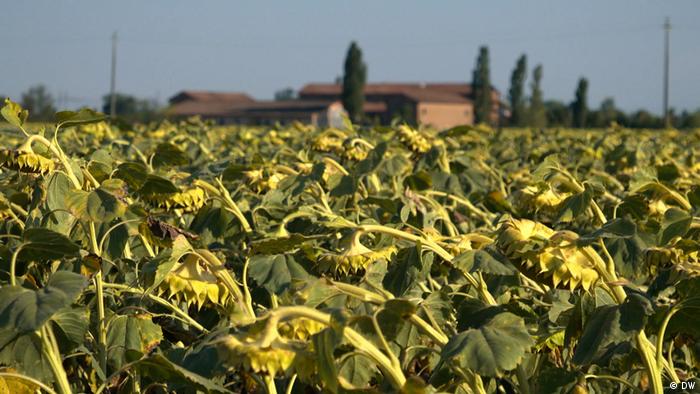
Due to the drought, sunflower yields in Europe in 2022 are expected to be 12% below the average of the previous five years
Nearly two-thirds of Europe is threatened by drought, according to a report by the Joint Research Centre, the European Commission's science and knowledge service.
The drought may be the worst "for at least 500 years," European Commission spokesperson Johannes Bahrke said on Tuesday.
"This is of course only a first assessment, and we need to confirm this with final data at the end of the season," Bahrke said, referring to the report, which was published on Monday.
Details of the EU report on drought
According to the report, 47% of Europe is under warning conditions, with a clear deficit of soil moisture. A further 17% is in a state of alert, in which vegetation is affected.
Scarce rain and successive heat waves that began in May have affected river discharges and water levels.
"The severe drought affecting many regions of Europe since the beginning of the year has been further expanding and worsening as of early August," the report found.
What are the consequences of the drought in Europe?
The dry conditions have already affected inland waterway transport, power generation and yields of certain crops in Europe.
Low water levels have forced shippers to reduce their loads on waterways such as the Rhine. Reduced water volumes have also adversely affected the energy sector for both hydropower generation and cooling systems of other power plants.
Summer crops have suffered, with 2022 yields for grain maize set to be 16% lower than the average of the previous five years and soybean and sunflowers yields set to fall by 15% and 12%, respectively.
"Soil moisture and vegetation stress are both severely affected," the report found, listing over a dozen countries where drought hazard has been increasing, including Germany, France and Britain. "The rest of Europe, already affected by drought, maintains stable severely dry conditions," according to the report.
Asit Biswas, visiting professor at the University of Glasgow, told DW said that the water crisis is a "crisis of management."
"We have plenty of water for everything we want," Biswas said, adding that management over the last several decades has been unsustainable.
"We have really poor management all over the world, and we're blaming it on water scarcity," he said. He argued that even with climate change and prolonged droughts and floods, better management would allow humanity to weather the crisis.
"There are some places now [where] they're losing 60% of water" due to faulty infrastructure, Biswas said.
Biswas argued that lawmakers "only get interested when there is a prolonged drought or a prolonged flood." "The moment the flood disappears, water disappears from the agenda."
Conditions will not improve in coming months
Regions where conditions are deteriorating the most are those that were already affected by drought in spring 2022 — including northern Italy, southeastern France, and some areas of Hungary and Romania — according to the report.
Researchers forecast that conditions in the western Euro-Mediterranean region are likely to be warmer and drier than normal through November.
Britain will also need to continue to manage water resources carefully over the coming weeks and months to meet its needs following the driest summer for 50 years, the National Drought Group announced on Tuesday.
According to the group, which is made up of government officials, water companies and environmental organizations, there is enough water for all essential household and business needs. Ten of the Environment Agency's 14 areas in England are now in drought status.
dh/rt (dpa, Reuters)Date 23.08.2022
Cecilia Nowell
Sat, August 20, 2022

Photograph: Hitendra Sinkar/Alamy
Over the course of human history, scientists believe that humans have cultivated more than 6,000 different plant species. But over time, farmers gravitated toward planting those with the largest yields. Today, just three crops – rice, wheat and corn – provide nearly half of the world’s calories.
That reliance on a small number of crops has made agriculture vulnerable to pests, plant-borne diseases and soil erosion, which thrive on monoculture – the practice of growing only one crop at a time. It has also meant losing out on the resilience other crops show in surviving drought and other natural disasters.
As the impacts of the climate crisis become starker, farmers across the world are rediscovering ancient crops and developing new hybrids that might prove more hardy in the face of drought or epidemics, while also offering important nutrients.
Related: Our food system isn’t ready for the climate crisis
“You hear all the statistics like, ‘We’ve lost 90% of our varieties’. It’s only recently that I realized the greatest sadness isn’t that we’ve lost that diversity. It’s that we don’t even know that we’ve lost that diversity,” says Chris Smith, founder of the Utopian Seed Project.
Here’s a look at five crops, beyond rice, wheat and corn, that farmers across the world are now growing in hopes of feeding the planet as it warms:
Amaranth: the plant that survived colonization

Indigenous farmers have long grown this drought resistant crop, which is now experiencing a resurgence. Photograph: Picture Partners/Alamy
From leaf to seed, the entirety of the amaranth plant is edible. Standing up to eight feet tall, amaranth stalks are topped off with red, orange or green seed-filled plumes. Across Africa and Asia, amaranth has long been eaten as a vegetable – whereas Indigenous Americans also ate the plant’s seed: a pseudocereal like buckwheat or quinoa.
While amaranth leaves can be sautéed or cooked into a stir-fry, the seed is commonly toasted and then eaten with honey or milk. A complete protein with all nine essential amino acids, amaranth is a good source of vitamins and antioxidants.
In the Americas, Spanish colonizers banned the Aztecs and Maya from growing amaranth when they arrived on the continent. However, the plant continued to grow as a weed and many farmers saved amaranth seeds, passing them down for generations, until their descendants were allowed to grow it again.
Today, Indigenous farmers in Guatemala, Mexico and the US are collaborating to grow this drought-resistant crop. Like fonio, an African grain, amaranth is not a new crop, but one that is experiencing a resurgence as communities adapt to the climate crisis. “Everything that’s new was old once,” said Matthew Blair, a professor at Tennessee State University and co-president of the Amaranth Institute.
Amaranth has found its way into European kitchens, with Ukraine coming in as the crop’s largest producer on the continent.
Fonio: the drought-resistant traditional grain

Farmer Jeane Pierre Kamara 49, sows fonio cereal seeds on freshly plowed land along with fellow farmers in the fields of Neneficha, south-eastern Senegal. Photograph: Andy Hall/The Guardian
For thousands of years, farmers across west Africa have cultivated fonio – a kind of millet that tastes like a slightly nuttier couscous or quinoa. Historically, fonio is considered to be Africa’s oldest cultivated cereal and was regarded by some as the food of chiefs and kings. In countries such as Senegal, Burkina Faso and Mali, fonio would be served on holy days, like at weddings and during the month of Ramadan.
Today, attention is increasingly focused on fonio for its resilience and health benefits. As the climate continues to change, fonio’s drought resistance and ability to grow in poor soil has made it a standout crop in water-scarce regions. It also has important nutritional value as a low glycemic, gluten-free grain – making it a good source of amino acids for people with diabetes or gluten intolerance.

A Freshly cooked fonio dish with chicken, served in a restaurant in the Neneficha area, south-eastern Senegal.
While Europeans once called fonio “hungry rice”, European companies are now manufacturing their own fonio. The Italian company Obà Food helped introduce fonio to the EU in December 2018. And in the US, the Senegalese chef Pierre Thiam sources fonio from the aid organization SOS Sahel for his brand Yolélé, also the name of his cookbook celebrating west African cuisine.
Cowpeas: the fully edible plant
In the 1940s, more than 5m acres of cowpeas were grown in the US – the majority, as their name suggests, for hay to feed livestock. But long before cowpeas – also called southern peas or black-eyed peas – came to the Americas, they were grown for human consumption in west Africa. Although cowpea production has declined in the US in recent decades, the crop is hugely important in much of Africa. Nigeria is the world’s largest cowpea producer.
As scientists look for alternative crops, Blair said it was important to identify ones where the entire plant is edible. Although historically people have mostly eaten cowpeas’ seeds, the leaves and pods are also a good source of protein.
Because cowpeas are highly drought tolerant, they’re also a good candidate as the climate changes. At Tennessee State University, Blair is part of a team studying the introduction of cowpeas to Latin America, as an alternative to beans, like pinto and black beans, with similar flavor profiles that may soon become more difficult to grow.
Taro: adapting the tropical crop for colder climes
In the tropics of south-east Asia and Polynesia, taro has long been grown as a root vegetable, not unlike the potato. But as rising temperatures threaten cultivation of the crop in its natural habitat, farmers in the continental US are trying to adapt the tropical perennial to grow as a temperate annual, because it cannot survive the cold of US winters.
At the Utopian Seed Project in North Carolina, founder Chris Smith and his team have been experimenting with tropical crops, looking for ways to help the plants survive the winter. Today, they’re growing eight varieties of taro, including ones sourced from Korea, the Philippines, Hawaii, China and Puerto Rico.
“We want to introduce taro because we truly believe that that will give us a more secure food system,” Smith says. “But the beautiful byproduct is that that also allows us to engage with foods that are traditionally from either Indigenous or peasant farming communities. And I think it really gives those traditionally underserved populations an opportunity to engage with the food system that they don’t usually get.”
Like fonio, amaranth and cowpeas, taro isn’t a new crop – it’s just new to the US food system. Which is why the Utopian Seed Project isn’t just learning how to grow taro, but also teaching people how to cook it. “These crops are just foods that are embedded in cultures around the world in a way that they’re not embedded here,” Smith said. “It takes work to build that community and desire for that crop.”
Kernza: the crop bred for the climate crisis
While many alternative crops are just plants that were grown somewhere else in the world generations ago, others have been cultivated specifically to withstand climate change.
In the 1980s, researchers at the Pennsylvania-based Rodale Institute identified a wheat-like grass called intermediate wheatgrass as a perennial cereal crop that could be developed as a substitute for annual grains like wheat. The goal was to minimize the environmental impacts of grain production.
In 2019, the Kansas-based Land Institute, a non-profit research organization focused on sustainable agriculture, introduced Kernza, a cereal crop developed from intermediate wheatgrass and trademarked to ensure farmers know they’ve bought seeds from the official breeding program. Although researchers are still working to improve the grain’s yield, farmers in Minnesota, Kansas and Montana are today growing nearly 4,000 acres of Kernza.
“Growers immediately understand the benefits of perennials on their landscapes,” said Tessa Peters, director of crop stewardship at the Land Institute, “and for those working in grain-producing areas, Kernza is very appealing.”
How climate change threatens Kashmir's crucial apple industry
As Indian-administered Kashmir continues to witness abnormally high temperatures, apple growers fear that climate change will wipe out the region's orchards — which produce 80% of India's apples.
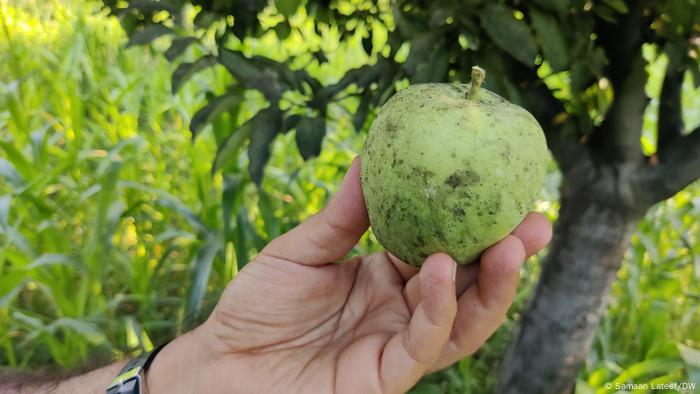
Apple farmers have complained that heat waves and humidity are causing dark smudges on the surface of apples
Sharp temperature variations across India-administered Kashmir have brought unseasonal snowfalls or early summers, resulting in heavy damage to apple orchards.
An almost 30% decline in apple production has dealt a serious blow to the region's biggest industry, leaving farming families with huge debts.
Nearly 1 million families are associated with Kashmir's $1.25-million (€1.23-million) apple industry — which, according to official records, produced 1.8 million metric tons last year, nearly 100,000 fewer than the previous year's crop.
Apple farmers feel the heat
A sudden dip in temperature causes the buds to fall and prevents the movement of bees necessary for pollination. On the other hand, an abnormal rise in temperature triggers a high incidence of infectious diseases, resulting in a decline in productivity, growers say.
In March, the average daytime temperature usually hovers around 15 degrees Celsius (59 degrees Fahrenheit) — but in March this year, the mercury rose significantly, causing Kashmir's apple crop to blossom early.
Sharp temperature fluctuations followed, resulting in the fall of the fruit buds and the spread of infectious diseases.
Farmers have complained that ongoing heat waves and humidity have caused dark smudges to appear on the surface of apples, described by experts as sooty blotch and flyspeck disease, adversely affecting the quality of the crop.
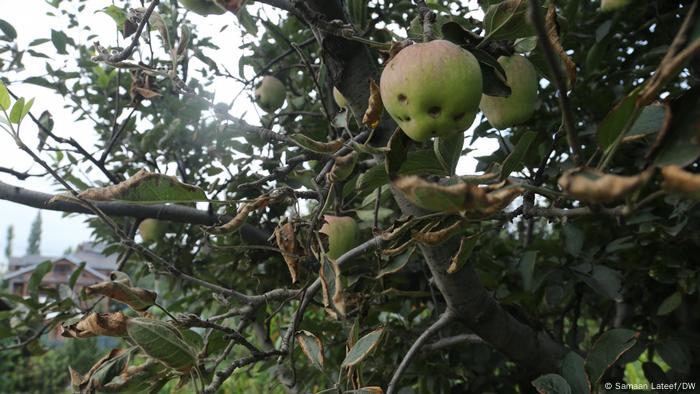
Losses in the apple industry have forced thousands of people out of the sector as traders wind up their businesses
"The past four years have given us nightmares," said Shameema Hassan, the wife of a well-known apple grower in north Kashmir's Baramulla district. "The apple crop has become vulnerable to diseases due to changing weather patterns."
"It will be either good crop but largely infected, or vice-versa," she added.
The consequential recurring losses have sharply affected their livelihood, forcing them to move their daughter from a private school to a public one, where education is free but learning standards are abysmal, Hassan told DW.
Lost business
The northern part of Indian-administered Kashmir is known as the region's apple bowl as it produces the highest quantity of apples.
Over the decades, the apple orchards have grown through its "karewas" — or elevated tableland — and major chunks of paddy land were converted into apple orchards in order to generate higher profits.
Until 2018, Hassan's family produced 3,000 boxes of apples annually; but production has since plummeted to just 700.
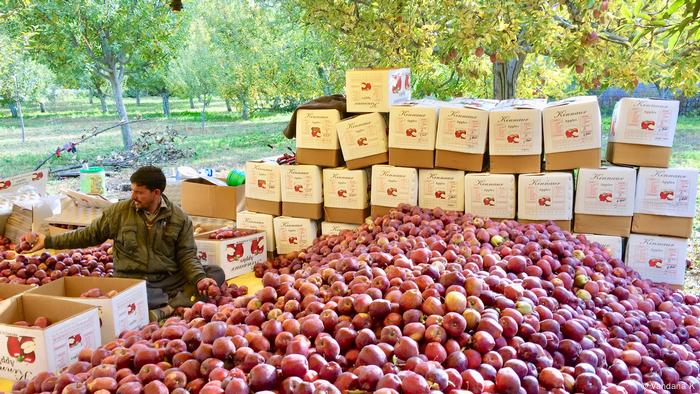
The region produces 80% of India's apples
"Normally, this year I should have produced 4,500 boxes of apples because new apple trees have grown to fruit-giving age — but the production is declining," she said.
In 2016, her family had an annual turnover of 20 million rupees (€248,000). But now, losses have landed them heavily in debt.
"We owe nearly 10 million rupees to banks and apple traders," Hassan said. "We have started a copper shop to feed the family. We hate going to the apple orchards."
According to data from the meteorological department, there has been 70% to 80% less than normal precipitation in Kashmir this year.
Crop damage
Shabeena Malik, a science teacher in Kashmir, said the increased temperature has resulted in a widespread attack of aphids, causing irreversible damage to the apple trees.
"Despite multiple sprays of insecticides, these aphids have gone out of control," said Malik, whose family owns nearly 40 acres of apple orchards.
The use of substandard pesticides is also a major cause of damage to the apple, which puts an additional economical burden on growers, who are in debt in absence of insurance coverage from the government, she said.
"The intensity of insects and pests has shown an increase this year due to the early high temperature in spring," said Ashiq Hussain, a fruit scientist at the Sher-e-Kashmir University of Agriculture Sciences and Technology in Srinagar.
"Once we cross 30-degree temperatures, the entire apple orchards get wiped out because seeds will cease to grow," she told DW.
Hussain said Kashmir would normally never have experienced hailstorms in June. But their intensity has increased, badly damaging the apple crop.
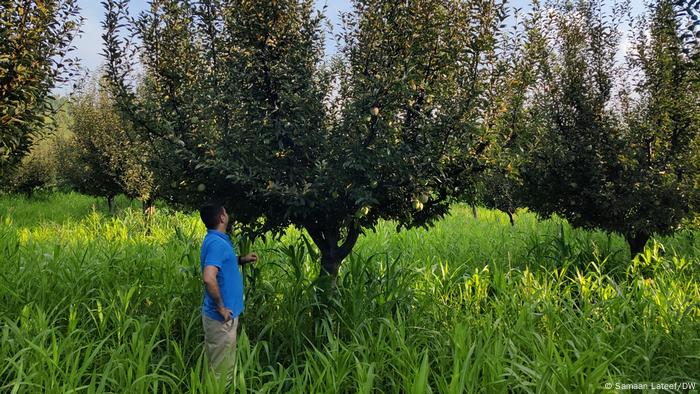
Substandard pesticides put an additional economical burden on growers
Debt-ridden apple growers shift to other crops
As the Kashmir apple is "facing a danger of becoming a rarity in India due to recurring production losses," Malik said the farmers are gradually moving to alternative crops.
In hundreds of apple orchards across Kashmir, farmers have sown wheat, mustard, maize and legumes.
Instead of cutting down the trees, the farmers said they have brought back wheat growing, which acts a major attraction to rodents that damage the roots of the apple trees, to "facilitate their silent death."
Ghulam Hassan Bhat, 57, an apple grower in north Kashmir's Baramulla district, is among farmers with an emotional attachment to his apple orchards, which provided his main source of income for decades.
Bhat used to run an apple trade worth millions of rupees. But recurring losses over the past four years have thrown him into debt — forcing him to shut that business and turn to wheat cultivation.
"Let the rodents silently destroy the apple trees, I have started with the cultivation of wheat. The apple trade is a no-go zone for us now. It will take a lifetime to pay the debt to the banks and traders," Bhat told DW.
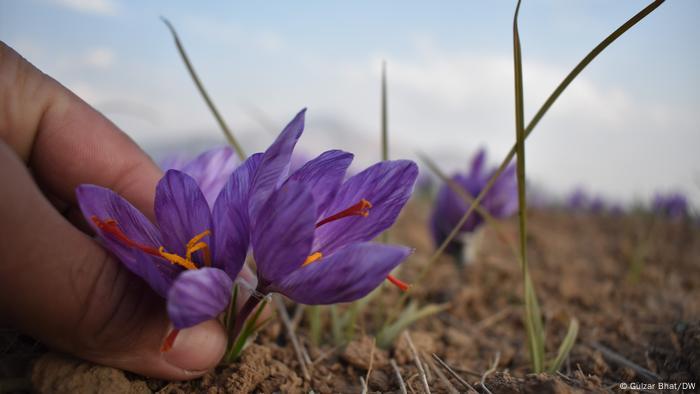
Saffron is one higher-value crop grown in Kashmir
Switching to low-paid jobs
The losses in the apple industry have forced thousands of people out of the sector as traders wind up their businesses.
Muhammad Shafi Var, who lives in Sheikhpora village in Baramulla district, said he was earning nearly half a million rupees annually (more than $6,000) from his apple orchard — but now he earns just $100 a month working in a hotel in south Kashmir's Pahalgam tourist resort.
In 2018, Var produced 1,000 boxes of apples. But now, production has dwindled to fewer than 200 boxes.
Var said that if his apple orchards, which are located on elevated tableland, were to get adequate irrigation, he would cut down the trees and cultivate wheat and paddy.
"At least I can produce enough food to fill the stomachs in my family," he said.
Edited by: Keith Walker
DW RECOMMENDS
K-pop has become South Korea's export hit, and the music has found a decent — and growing — fan base in Germany. What's the hype about?

Europe's first major K-pop festival was held in Frankfurt in 2022
South Korea is one of the fastest-growing music markets in the world. The reason for this: K-pop. The international spread of the music genre earns the country several billion euros a year. The fact that South Korean pop music has become so successful is thanks in no small part to social media and a networked fan community, including in Germany.
But the hype doesn't stop there: People in more and more countries are getting excited about South Korean pop music. But why are they so fascinated with it?
A mix of fun and community
"K-pop is just something that brings me joy," says Melissa Ndugwa. The 21-year-old is the co-founder of K-Fusion Entertainment, the largest K-pop fan gathering in Germany. What excites Ndugwa about K-pop?
"Listening to the music, practicing the choreography and then dancing together with others is so much fun," says Ndugwa. Dancing together is not only a popular activity among fans but a central part of K-Pop. The performance of the idols, as the Korean pop stars are called, is as important as the music. The recipe for success is catchy melodies, sophisticated choreography and slick performers.

Members of the Frankfurt K-pop fan group K-Fusion Entertainment practice their moves
K-pop metropolis: Frankfurt
The K-pop stars are role models for many of their fans in terms of beauty ideals, as well. For some years now, Korean beauty and care products have been booming in Germany. There are salons offering Korean cosmetics and skin care in several German cities, including Frankfurt. This is where Germany's largest Korean community lives, and the city has now become Germany's K-pop metropolis.
In May 2022, Europe's first major K-pop festival was held in the central German city, with 70,000 spectators. Titled KPop.Flex, it was attended by stars such as Monsta X, Mamamoo and NCT Dream. The Seoul Broadcasting System (SBS), a private television and radio station from South Korea, was also involved in organizing the event. Apparently, they suspected that Germany could turn out to be a lucrative market.

Tens of thousands of people flocked to Frankfurt for the KPop.Flex festival
"Actually, the K-pop community in Germany is still small compared to the US, Asian and other European countries. But, this year, we've noticed a big change. There have been many more concerts by Korean artists. And there has never been a festival in Europe like the one in Frankfurt," says Kocky B, the leader of the K-pop dance group Shapgang. The 12-member group from Frankfurt performs at competitions and on TikTok, where they dance the choreographies of popular K-pop bands, but also perform their own choreographies.
The standard: Perfection
Kocky B says her fascination with K-pop comes from the focus on the visual elements, dance and the colorful, in-your-face, fun production, which she has not seen in the Western music industry.
"When we started, there were few people who even knew what K-pop was. It tended to be laughed at in the dancing scene," she says. "That has changed tremendously, because the K-pop industry offers many job opportunities for dancers. People now realize how significant this market is. Many Western dancers are hired by K-pop labels to develop choreography."
In K-pop choreographies, the stars dance in flawless synchronicity, and they do so in groups of up to 20 members. It's all about synchrony, community — and perfection. This also applies to the music, as Isabelle Opitz, editorial director of the German pop culture magazine K*bang Magazin explains.
"The music itself is produced to a very high standard, and songwriters from the European region are often involved. A label will bring a huge team to Korea. There's not much that can go wrong. As a fan, you know what you're getting right from the start," says Opitz.
K-POP AS A ROUTE TO JAPAN-SOUTH KOREA RECONCILIATION?It's time for K-popYuuka Hasumi (17) is one of the Japanese youth who joined ACOPIA School in Seoul. It is a dance/vocal academy run under the ACOPIA Entertainment division. This division offers not only lessons on how to sing and dance like their favorite stars, but also on the Korean language and culture.
Social media takes on a central role
K-pop also works so well because it offers a huge package of interaction opportunities, Opitz says. Fans watch every music video, every interview appearance and are well informed about the individual group members.
In addition, many idols star in series or movies, and communication via social media is perfectly coordinated. "Through platforms like Spotify and YouTube and social networks such as Twitter, K-pop has become more accessible; the community is more connected," Opitz says. "Even if you have nothing to do with K-pop at all, YouTube suggests content to you." Today, there is someone in every German school class who listens to K-Pop, Opitz says.
K-pop idols: Role models?
This success should not obscure the fact that there are also downsides. K-pop is a hard-hitting industrial product; the bands are put together by entertainment corporations. Young people are signed up and trained in a targeted manner — in sometimes exhausting and somewhat dubious programs. Those who are convincing get a place in a group.
The price of success is high: Time and again there is talk of gagging contracts that forbid the idols to have a relationship in public. There have been reports of eating disorders and even suicides among K-pop stars.
"Compared to the past, the community has become more attentive to the reality of the industry," says Melissa Ndugwa. Idols are still role models, she says, but are no longer glorified as much. "In K-pop, it's already a scandal if an idol dates anyone. There are stars who were ostracized for it and had to end their careers. At the same time, they are only human."
This article has been translated from German.
K-POP: THE SCANDALS AND TRAGEDIES OF 2019More and more deathsCha In-ha, a popular South Korean actor-singer, was found dead at his home on December 3, 2019. A police official told media that the cause of Cha's death was not immediately known. The 27-year-old celebrity made his film debut in 2017 and was part of the Surprise U band, which released two albums. There were no reports to suggest that Cha had been a target of personal attacks or cyberbullying.
Date 18.08.2022


